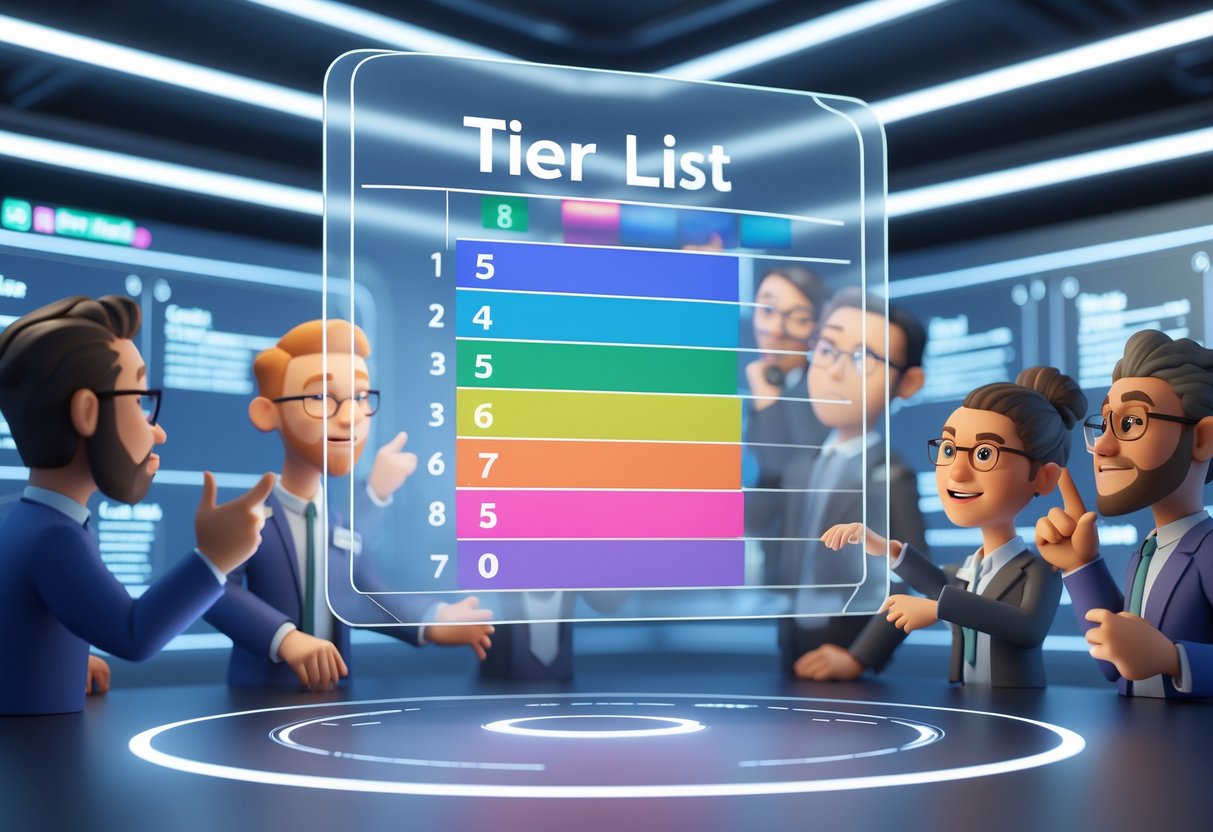Tier Lists Accuracy Debate: Analysing Ranking Validity and Discussions
Updated On: November 12, 2025 by Aaron Connolly
Defining Tier Lists and Their Role in Rankings

People use tier lists to organize game elements into ranked categories with letter grades. Higher tiers mean stronger or more viable options.
To make a tier list work, you need clear criteria and a standard ranking system. The S tier and other labels create a hierarchy, helping players figure out competitive value.
Key Components of a Tier List
A tier list really needs three things. First, you need clear criteria—are you judging by tournament performance, how easy something is to use, or just overall strength?
The ranking system usually borrows from academic grading. S tier sits at the top, then A, B, C, and sometimes D.
Visual organisation matters, too. You’ll see characters or items in rows—best at the top, weaker ones below.
Context changes everything. A beginner’s tier list won’t match one made for pro players.
Skill level, game mode, and the current meta all shuffle rankings around.
Quick win: Before trusting a tier list, check if it explains its criteria and who it’s made for.
Understanding S Tier and Other Categories
S tier stands for the best of the best. The “S” actually comes from Japanese grading, where it sits above the usual A-F scale.
S tier picks dominate competitive play. They mix power, versatility, and reliability, so most pros lean toward them.
A tier options are strong and work well, but maybe have a minor flaw or two. They’re solid alternatives if you don’t want to pick from S.
B and C tiers are average or below. B tier can work in certain situations or with specific teams. C tier usually takes more skill or has big drawbacks.
Heads up: Some lists go down to D or F for really weak stuff, but a lot just stop at C to avoid trashing game balance too much.
Why Tier Lists Spark Accuracy Debates

Tier lists always seem to spark passionate debates. People bring personal experience, but also try to be objective.
The clash between what players love and what the numbers say is where most arguments start.
Subjectivity Versus Objectivity in Rankings
Personal gaming experience shapes how we see rankings. If you crush games with a “low-tier” character, you’ll probably question any list that puts your main at the bottom.
Things that mess with perception:
- Playstyle preferences—aggressive players want different things than defensive ones.
- Skill level gaps—new players might struggle with “top-tier” but tricky characters.
- Platform differences—console controls vs. PC can totally change what works.
Communities build their own mini-metas. Something that’s great in casual games might flop in pro tournaments.
Arguments heat up when tier list creators say they’re objective but make subjective calls anyway. You see this a lot in fighting games—frame data looks ironclad, but matchup knowledge is all over the place.
Role of Data and Evidence
Stats can make a tier list look more credible, but people argue about how to read the data. Tournament win rates sound solid, but they only show what happens at the top level.
Where the data comes from:
- Pro tournament results
- Pick rates in different skill brackets
- Win percentages
- Community surveys
But which data matters most? A character might be a beast for beginners but flop at high ranks.
A lot of creators cherry-pick stats that back up their opinions. Others just ignore important stuff, like when a patch dropped or how big the sample size was.
People also argue over what counts as “real” evidence. Some swear by tournament data and ignore casual stats—even though most players are casuals.
Impact of Community Bias
Communities get attached to certain characters or weapons. That emotional connection colors how people judge tier lists.
Common community biases:
- Nostalgia bias—old content gets bumped up because of fond memories.
- Popularity bias—if everyone uses it, it must be good, right?
- Underdog bias—fans defend lesser-known picks just because they’re underdogs.
Social media makes this worse. Players end up in echo chambers, so everyone just repeats the same opinions.
The most controversial lists are the ones that go against what the community believes. If a big-name creator puts a fan favorite in the bottom tier, things get personal fast.
Big communities can drown out smaller voices, too. If enough people shout for their favorite, it starts to look “official” just from sheer noise.
Evaluating the Criteria Behind Rankings

A tier list’s accuracy really depends on what you use to measure performance. If the metrics don’t fit the situation, the rankings won’t mean much.
Knowing how people evaluate things helps you tell if a ranking is legit or not.
Common Metrics Used
Most tier lists lean on numbers. Win rates are the go-to metric in competitive games.
Performance-based metrics:
- Win/loss ratios—shows who wins most often.
- Pick rates—how often people choose something.
- Ban rates—if it’s always banned, it’s probably strong.
- Damage output—raw numbers, plain and simple.
Tournament results add another layer. But pro play and casual play can look totally different.
Statistical weighting matters. Ten thousand matches at 55% win rate mean more than 100 matches at 70%.
Some lists blend different metrics together. Weighted averages help, but only if the method is clear.
Community input plays a role, too. Surveys and expert opinions can spot things that stats miss.
Importance of Contextual Relevance
Context is everything. What works for esports pros might not matter at all to casual players.
Skill level context is huge. Some characters stomp at low ranks but disappear at the top.
Meta shifts can wipe out a tier list overnight. Patches, new rules, or new strategies keep changing the scene.
Regional differences add another wrinkle. What dominates in Europe might flop in Asia.
Time sensitivity matters. Using old data for a fast-changing game just leads to bad rankings.
Sample size issues pop up, too. Rare picks might not have enough data, but they can still work in the right hands.
Data Collection and Challenges in Tier Lists

Building a good tier list means collecting data from all over, but every source has its own problems. The rankings only work if you deal with these data collection hurdles.
Sources and Types of Data
Creators usually grab data from a few main places. Tournament results give a solid, objective base—they show who’s winning at the top.
Community feedback brings in what experienced players notice. Forums, Discord, and social media are packed with opinions and stories.
Stat databases track win rates, picks, and performance. Games like League of Legends or Valorant have tons of match data to dig through.
Pro player opinions carry a lot of weight. When top players speak up about what’s strong, people listen.
Content creators—streamers and YouTubers—test stuff out and share their thoughts with big audiences.
Balancing all this isn’t easy. Tournaments might say one thing, but the community might feel the opposite.
Limitations of Available Information
Sample size is a big issue. Smaller tournaments don’t have enough data to say much about what’s good.
Meta shifts move faster than data can keep up. A patch can flip everything before anyone updates their tier list.
Regional differences mess with the numbers. What wins in Europe might lose in Asia.
Skill level bias is everywhere. Data from top players might not mean much for the average person, but lists often act like they’re universal.
Recency bias creeps in, too. People put too much weight on the latest tournament, even if it’s a fluke.
Access limitations hold things back. Not all tournaments share their stats, and some regions barely have any public data.
So, even the best-researched tier lists have blind spots and assumptions.
Debates in Gaming and Competitive Communities
Gamers love to argue about tier lists. Debates get especially wild after a big update or when a popular creator posts a hot take.
How Meta Changes Affect Rankings
Game updates can turn tier lists upside down overnight. When devs buff or nerf characters, everyone scrambles to figure out what’s actually good now.
Freddy’s rework in Dead by Daylight is a perfect example. Suddenly, players started saying he deserved a much higher tier. “Freddy is no longer rubbish tier, he is much higher after the rework,” popped up everywhere.
Character reworks spark instant drama because:
- Old lists become useless overnight.
- Players need time to learn new strategies.
- First impressions are often wrong.
The Houndmaster debate is another classic. Some swear he’s got the fastest chases, while others keep him in the lower tiers.
Meta shifts don’t hit everyone the same. A character might climb the ranks for pros but stay the same for casuals. That just gives people more to argue about.
Examples of Heated Discussions
Recent tier list controversies show just how fired up players get. Dead by Daylight’s killer tier list, for example, caused a storm on forums.
Disputes over placements are everywhere:
- “Putting Ghostface in B is generous” pops up a lot.
- “Spirit, Artist, Plague and Dracula are way too low” is another common complaint.
- People wonder why some killers rank below Nurse and Blight.
Call of Duty tier lists get slammed, too. Some players called recent lists “horrific,” especially for skipping Warzone.
Platform wars make things even messier. PlayStation, Xbox, and PC fans all make their own lists, each saying their platform is best.
The Tekken community is split, too. Some say tier lists ignore what average players need, while others think they’re useful for picking new characters.
Influence of Tier Lists on Decision-Making
Tier lists definitely shape how players make decisions. They point people toward what looks like the best choices.
But these rankings can cause confusion if you ignore context or try to use general lists for specific situations. Sometimes, it’s just not that simple.
Guidance and Misconceptions
Players tend to treat tier lists like a GPS for competitive games. They’ll check these rankings to figure out which characters or strategies seem best right now.
Honestly, the appeal is obvious. Why bother with a lower-ranked pick if there’s an S-tier one available?
But here’s where things get messy. A lot of people just skip straight to the rankings and ignore the explanations or how the list was made.
That causes a few problems:
- Players start thinking S-tier means “always best,” not “best in certain situations”
- Lower-tier picks get tossed aside, even though they can work great for casual play
- People forget about their own skill level and what playstyles they actually enjoy
Gaming experts keep saying you need to learn enough to make your own tier list. That way, you’re not just following rankings that don’t fit your skills or goals.
The smartest move? Treat tier lists as a jumping-off point, not gospel.
Effects on Player or Consumer Choices
Tier lists have a huge effect on which characters players pick and what strategies they try. Research shows rankings can pull people in and shape how we judge our choices.
Basically, public opinion flips fast when tier lists update. If a character jumps from B-tier to S-tier, suddenly everyone’s playing them.
Content creators need to be careful with accuracy, since their tier lists pull in tons of engagement. Heads up: Over-the-top rankings can mess with how the community sees things and set up unrealistic expectations.
It doesn’t just affect individuals:
- Meta shifts happen when enough people follow tier list advice
- Community talks start to focus on tier placement, not gameplay itself
- New players flock to top-tier picks instead of learning the basics
Even when tier lists say “play what you like,” most players still let rankings guide their big decisions. This happens even if the list spells out its own limitations.
The big challenge is getting players to see tier lists as snapshots of current thinking, not some unchangeable truth about balance.
Subjectivity, Bias, and Interpretation
Personal taste and what’s trending really shape how we rank things in tier lists. Even the most “objective” list ends up being surprisingly subjective. People keep debating if any tier list can ever really be fair.
Personal Preferences in Tiers
We all bring our own gaming backgrounds and favorites to tier lists. Someone who loves aggressive play will usually bump up rushdown characters above defensive ones.
This makes discussions tricky. Something that feels broken to one player might seem balanced to someone else. Our skill level plays a big part too.
A new player might struggle with a “top-tier” character that pros love. Meanwhile, they might pick up a “bad” character and do just fine.
Your gaming history changes your view as well. Players from fighting games see different strengths than those who come from MOBAs or shooters.
Community tier lists often show the creator’s own preferences more than cold hard data. Popular streamers and YouTubers sway thousands with their personal rankings.
Compare a few tier lists and you’ll see the bias. The same character sits in S-tier on one list and B-tier on another.
Influence of Popularity and Trends
Popular picks and strategies shoot up tier lists, even when the numbers don’t back it up. We just tend to rank what’s trending higher.
Social media only makes this stronger. A viral highlight can make a character look way better overnight.
Tournament wins shake up tier lists too. If a pro wins with a surprise pick, suddenly that character jumps up a few tiers.
Popularity bias hits casual and competitive scenes in different ways. Casual players follow streamers and content creators. Competitive players care more about tournament results and frame data.
Meta shifts move faster than actual balance changes. We often update rankings based on what everyone thinks, not on new patches.
When the whole community believes something’s strong, everyone uses it, and that creates more “evidence” it’s good.
Regional differences show up too. Korean tier lists don’t always match European ones, even for the same game.
Tools and Platforms for Creating Tier Lists

Plenty of online platforms make it easy to build tier lists. The most popular sites let you drag and drop, use loads of templates, and share your lists with others.
Popular Tier List Generators
TierMaker leads the way with more than a million templates, covering everything from game characters to sports teams. You can build custom templates or use ones the community already shared.
You don’t even need to register for basic features. Just upload your images and start ranking with their simple interface.
Simplified brings professional-grade tier list creation and AI-powered design tools. The free plan gives you basic templates, while premium (£12/month) unlocks collaboration and branding.
Canva offers slick tier list templates as part of its design suite. You’ll get animated elements and millions of stock images to spice up your rankings.
If you’re on mobile, TierUp has an app for that. The free version gives you nine color themes and several export options, with extra features behind in-app purchases.
Community-Driven Features
Most tier list sites thrive on community sharing. TierMaker lets users publish custom templates for others, building a huge library of rankings.
Tier List Maker is all about community content. You can browse popular templates or add your own.
Sharing works differently on each platform. TierMaker supports direct posting to X (Twitter) and Facebook, while Simplified offers wider social media integration through its content tools.
A lot of platforms also let multiple users edit the same tier list together.
Best Practices for Increasing Accuracy

Building a reliable tier list takes systematic methods that cut down on bias and boost data quality. Clear criteria and open processes help your audience trust your rankings.
Establishing Clear Evaluation Criteria
Every good tier list starts with clear criteria. We need specific, measurable factors that apply to everything on the list.
Define measurable metrics. Instead of saying “good character,” use “damage per second” or “win rate in tournaments.” This cuts out guessing and bias.
Weight your criteria by importance. A fighting game list might value tournament wins (40%), frame data (30%), and matchups (30%). Spell out these weights so readers see your logic.
Use standard scoring for each factor. Go with scales (1-10) or percentages, not just vague descriptions. This keeps things more objective.
Review your criteria regularly. Patches and meta shifts can change what matters. Quarterly reviews work for active games; annual ones are fine for slower updates.
Utilising Transparent Methodology
Being transparent builds trust. If you document your methods, readers can see how you got your results.
List your data sources. Name the tournaments, databases, and time frames. Include sample sizes and admit any gaps in your data.
Explain your ranking steps. Show how you turned raw data into final rankings. This lets others spot mistakes or bias.
Track your changes. Keep a changelog and explain why you updated. Readers appreciate knowing what changed and why.
Share your raw data when you can. Upload spreadsheets or databases to back up your rankings. This shows confidence and invites feedback.
Real-World Applications Beyond Gaming

Tier lists aren’t just for games anymore. They’ve become go-to ranking tools across tons of industries. Whether you’re picking movies or just making daily choices, these systems help you sort through options.
Pop Culture and Entertainment
Tier lists are everywhere on social media when it comes to movies, TV, and music. Content creators on YouTube and TikTok love ranking everything from Marvel films to hit songs.
Netflix and other streaming services quietly use tier list logic too. They crunch viewing data to build internal rankings for their recommendation engines.
Entertainment journalists publish tier lists for award season picks. These help audiences guess which films might win Oscars or which albums stand out for Grammys.
Music fans make tier lists for artist albums or genres. A Taylor Swift fan might rank her albums from S-tier to D-tier, sparking debates all over social media.
It works because it’s visual and quick. You can see where your favorites land without reading a wall of text.
Everyday Decision Support
We use tier list thinking all the time, even if we don’t call it that. Restaurant apps like Deliveroo basically create tier lists based on ratings and speed.
Career advisors help students tier their university options by cost, location, and course quality.
Shopping comparison sites use ranking systems that look a lot like tier lists. They sort products by price, features, and reviews so buyers can decide faster.
Personal finance apps build tier lists for spending. They show what’s essential (S-tier) and what’s optional (C-tier) to help with budgeting.
Even dating apps use tier list logic in their algorithms, ranking matches by compatibility and preferences.
Ongoing Evolution and Updates of Tier Lists

Tier lists keep changing as new data comes in and the community gives feedback. This constant churn keeps rankings fresh and sparks new debates.
Adjusting to New Information
Game updates can totally flip character rankings. When Freddy got his rework, players started arguing he deserved a much higher tier than before.
Patch notes and gameplay stats drive most real updates. Pro match results sometimes clash with what the community thinks, so tier list creators have to balance different sources.
Buffs and nerfs hit skill levels in different ways. A champ might rule casual play but flop in pro tournaments. That makes it tricky to decide which data matters more.
New strategies pop up all the time. Players find tech that makes weak characters strong, or discover counters to top-tier picks.
Quick tip: Keep an eye on patch notes and pro matches to spot tier list changes before they go mainstream.
Community Revision and Feedback
Player discussions push tier lists to evolve way more than most creators admit. If hundreds of comments call out a ranking, smart creators dig in and check.
Communities spot weird placements fast. Forums light up when similar characters end up in totally different tiers with no real reason. This pressure usually leads to quick revisions.
Heads up: Not all feedback is equal. Personal bias and limited play can skew opinions.
The most accurate tier lists take feedback but stick to their criteria. Creators who explain their methods handle criticism better than those who just react.
Some creators now update their tier lists monthly, using both community feedback and new tournament results. This keeps rankings from getting stale.
Frequently Asked Questions

Players and fans always have questions about how accurate tier lists really are, especially when it comes to predicting results or spotting personal bias. These questions show just how complicated rankings can be.
How reliable are tier lists in predicting game outcomes?
Tier lists give you a general idea, not a crystal ball. They’re best for showing which characters or strategies usually do well against average players.
But player skill usually matters more than tiers in most games. A skilled player with a “bad” character can still beat someone inexperienced using a “top-tier” pick.
At the pro level, matches line up with tier lists a bit more. Pros squeeze out every bit of potential, so tier rankings tend to hold up better there.
What factors should be considered when evaluating the accuracy of a tier list?
The creator’s expertise really matters when you judge a tier list. If a professional player, coach, or analyst with actual tournament experience made the list, that’s a good sign.
Recent data makes a tier list much more accurate. When someone uses current patch notes or pulls from the latest tournament results, you get a better sense of the game’s current state.
Sample size plays a big role in reliability too. If a tier list comes from hundreds of high-level matches, it’s just going to be more trustworthy than one based on a handful of games.
Can tier lists be subjective, and how does this affect their reliability?
Every tier list has subjective elements, even the ones made by experts. The creator’s playstyle and personal preferences always sneak into the rankings.
Game modes can really shake things up. Some characters might shine in casual matches but just can’t keep up in serious tournaments.
Regional differences add even more subjectivity. What’s strong in Europe might flop in Asia or North America, mostly because of different playstyles.
How often should tier lists be updated to remain relevant and accurate?
Game patches usually kick off tier list updates. Big balance changes can push characters up or down the rankings in just a few days.
Monthly updates seem to work for games that keep evolving. It’s frequent enough to catch meta shifts, but not so often that it overwhelms people.
Tournament results should spark a fresh look at rankings. If a low-tier character suddenly wins a major event, the tier list probably needs a shake-up.
In what ways can personal bias impact the construction of a tier list?
Creators often bump up their favorite characters, even if they don’t mean to. Emotional attachment is tough to ignore, even for seasoned players.
Recent experiences can mess with rankings too. If a creator just lost to a certain strategy, they might rank it higher than the stats actually support.
Playstyle preferences leave blind spots. Aggressive players, for example, might not give defensive characters enough credit just because they don’t enjoy using them.
What are some common misconceptions about the use of tier lists in strategy formulation?
A lot of players think picking top-tier characters automatically means they’ll win. But honestly, you still need to practice, know the game, and make smart choices—no matter who you pick.
Some folks figure tier lists work the same for everyone, but that’s not really true. Characters that are easy for beginners might end up in a different spot compared to those that only shine with advanced skills.
People also tend to treat tier lists like they’re set in stone. In reality, the meta keeps shifting with patches and new discoveries, so those rankings can change pretty fast.

